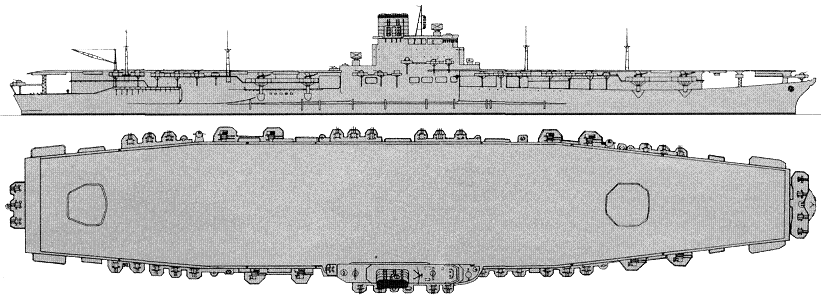

Shinano 1944
| Name | No | Yard No | Builder | Laid down | Launched | Comp | Fate |
| 信濃 [Shinano] | Yokosuka K K | 4.5.1940 | 8.10.1944 | 19.11.1944 | sunk 29.11.1944 |
|
Displacement standard, t |
62000 |
|
Displacement full, t |
71890 |
|
Length, m |
244.0 pp 256.0 wl 266.0 oa |
|
Breadth, m |
36.3 wl 41.5 fd |
|
Draught, m |
10.3 |
|
No of shafts |
4 |
|
Machinery |
4 sets Kampon geared steam turbines, 12 Kampon boilers |
|
Power, h. p. |
150000 |
|
Max speed, kts |
27 |
|
Fuel, t |
8900 oil |
|
Endurance, nm(kts) |
10000(18) |
|
Armour, mm |
belt: 206 - 160, flight deck: 76, main deck: 190 - 100, anti-torpedo longitudinal bulkhead 230 - 75 |
|
Armament |
8 x 2 - 127/40 89-shiki, 35 x 3 - 25/60 96-shiki, 40 x 1 - 25/60 96-shiki, 12 x 28 - 120 AA rockets, 47 aircraft (A6M fighters, D3A, D4Y diving bombers, B5N, B6N, B7A torpedo bombers, C6N recon planes) |
| Electronic equipment | 2x 1-shiki 2-go, 3-shiki 1-go radars |
|
Complement |
2400 |
Aircraft facilities (fd - 10,240m², ha - ~4,175m² / ~20,900m³): Flight deck: 256.0x40.0m. Hangar: 167.0x?x5.0m. There were fore (15.0x14.0m) and aft (13.0x13.0m) lifts. Aircraft fuel stowage: 718 300l.
| Year | fighters | diving bombers | recon planes |
| 11/1944 (planned) | 21 A6M5 | 21 D4Y1 | 6 D4Y1C |
Project history: Largest aircraft carrier of the Second World War, Shinano was laid down as third battleship of Yamato class. However experience of first battles on Pacific theatre has revealed the absolute superiority of deck aircraft over artillery of heavy ships, and in December, 1941 building of Shinano (ship was in 50% availability) was suspended. In summer of 1942, after battle at Midway, it was decided to complete the ship as an aircraft carrier.
Hull of Shinano was almost ready to the moment of works renewal, that has forced designers to go on defined compromises. Construction of an underwater part and anti-torpedo protection remained without changes. Barbettes of main gun turrets (the truth, without thick barbette armour) were stored even: there were fitted fast aviation ammunition elevators. Thickness of main belt (fitted on 15mm plates) was moderated to 160mm (instead of 410mm). It was not represented as possible to completely refuse the vertical protection as it was a part of hull structure and was continuation of an armoured anti-torpedo bulkhead (by the way, this bulkhead by upper edge was thicker, than the main belt!). On same reason it was necessary to store very thick (230mm) flat slope of main deck though on a horizontal part this deck over machinery became twice more thin: 100mm (instead of 200 on Yamato) and only over magazines its thickness increased to 190mm. Protection over main deck resembled Taiho. Deck between elevators had the same thickness; hangar sides walls were not protected. Aviation petrol tanks and steering compartments were protected by strongly armoured "boxes". As additional protection double bulkheads were widely used, the space between which was filled with water or concrete. Armour weight reached record size for aircraft carrier: 17694t, plus 2400t of concrete. Underwater protection of Shinano was identical to applied on Yamato. It included external bulges and three raked longitudinal bulkheads, first from which by an upper edge reached 200mm thickness. As a whole this system, despite insufficient breadth, ensured quite acceptable protection against underwater explosions. Anyway, in loss of Shinano weak readiness of crew was guilty but not construction of underwater protection.
On an applied naval architecture of Shinano the big effect has rendered by project of Taiho: in particular, island superstructure of new aircraft carrier has been simply copied from a prototype. However the flight deck should be made as a superstructure. Besides, almost ready hull of a battleship not allowed to place two-level hangar, therefore it was necessary to manage one-level. Accordingly size of air group of world largest aircraft carrier was only 42 (47 with spare) aircraft. But the aviation ammunition stowage was very impressive. Partly it spoke that it supposed to use Shinano as support carrier, intended for cover of first line carrier forces and their replenishing by aircrafts and ammunition.
New 100mm/65 guns of type 98 (as on Taiho) should become a basis of AA armament under the project, but because of shortage of the latter it was necessary to apply 127mm/40 guns of type 89. Light AA armament according to the project should consist from 35 triple 25mm MGs, but before completion ship received 40 more single MG and 12 28-barreled 120mm AA rocket launchers.
Ship protection: Main 160mm belt (on 15mm plating) protected about 2.3 of hull length and was closed by 25°inclined 340mm bulkheads. The belt was connected with main deck. 100mm main deck connected with main belt by 7°inclined 230mm outer parts (nearly slopes). Thickness of main deck increased to 190mm over magazines. Flight deck had 95mm (76mm armor on 19mm plating) thickness over hangar and 80mm over ship ends. Lifts had 50mm protection. Magazines had 180-70mm, aircraft fuel tanks 180-50mm and steering gear 125-50mm local vertical protection. Fun inlets and funnel uptakes were protected by 38mm armor. Underwater protection was 8m deep and content 230-75mm longitudinal bulkhead.
Modernizations: None.
Naval service: En route from Yokosuka to Kure for outfitting Shinano in the morning 29.11.1944 received amidships hits of four torpedoes from American submarine Archerfish. Owing to incomplete drainage system in 7.5 hours after attack carrier turned over and has sunk off Inamba Island.

Shinano 1944
© Ivan Gogin, 2008-14